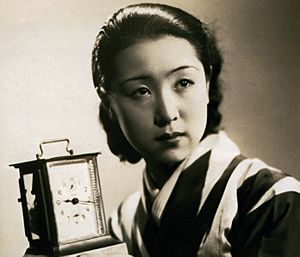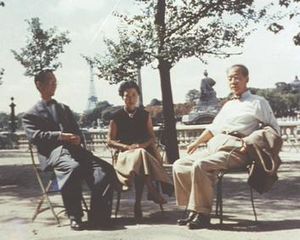Kinuyo Tanaka facts for kids
Quick facts for kids
Kinuyo Tanaka
|
|
|---|---|

Kinuyo Tanaka in Burden of Life (1935)
|
|
| Born | 29 November 1909 Shimonoseki, Yamaguchi, Japan
|
| Died | 21 March 1977 (aged 67) Japan
|
| Occupation | Actress, film director |
| Years active | 1924–1976 |
| Spouse(s) | Hiroshi Shimizu (1927–1929, not legally married) |
| Awards |
|
Kinuyo Tanaka (田中 絹代, Tanaka Kinuyo, 29 November 1909 – 21 March 1977) was a famous Japanese actress and film director. She worked in movies for over 50 years. During this time, she appeared in more than 250 films! She was especially known for her roles in movies made by director Kenji Mizoguchi, such as The Life of Oharu and Ugetsu.
Contents
Kinuyo Tanaka's Early Life and Career
Kinuyo Tanaka was born in Shimonoseki, Yamaguchi Prefecture, Japan. She was the youngest of nine children. Her family sold kimono (traditional Japanese clothing). Even though her family was once wealthy, they faced money problems after her father passed away in 1912.
Kinuyo learned to play the biwa (a Japanese lute) when she was young. In 1920, she moved to Osaka and joined a music group called the Biwa Girls' Operetta Troupe.
Starting Her Acting Journey
Kinuyo Tanaka's first movie role was in Genroku onna (meaning "A woman of the Genroku era") in 1924. This movie also marked the beginning of her work with the Shochiku Studios. She lived with director Hiroshi Shimizu for a while after acting in several of his films. They separated in 1929, but she still starred in some of his later movies. Kinuyo Tanaka never married and did not have children.
She quickly became a leading actress. In 1929, she appeared in Yasujirō Ozu's film I Graduated, But.... The next year, she played the main role in Aiyoku no ki. In 1931, she was in Japan's first sound film, The Neighbor's Wife and Mine, directed by Heinosuke Gosho. Gosho also directed her in The Dancing Girl of Izu (1933), based on a famous story.
Becoming a Star in the 1930s
In the 1930s, Kinuyo Tanaka became very popular. Many movie titles even used her name! Examples include Kinuyo monogatari ("The Kinuyo story") and Joi Kinuyo sensei ("Doctor Kinuyo").
In 1938, she starred in Aizen katsura with Ken Uehara. This movie made the most money before World War II. In 1940, she worked with director Kenji Mizoguchi for the first time in Naniwa onna ("A woman of Osaka"). This film is now lost. The next year, she was in Ornamental Hairpin, directed by Shimizu. Her acting in this film is still highly praised.
In 1944, she first worked with director Keisuke Kinoshita in the movie Army. This film is famous for its ending. It showed a mother (played by Tanaka) trying to see her son one last time as he marched off to war. This scene was a powerful message against the film's military theme.
Kinuyo Tanaka's Post-War Career

In October 1949, Kinuyo Tanaka traveled to the United States for three months. She was one of Japan's first cultural representatives after the war. When she returned, some fans found her new American manners a bit strange. She decided to leave Shochiku Studios and work as a freelance actress. This gave her more freedom to choose which directors she wanted to work with.
She then worked with many famous directors like Mikio Naruse, Ozu, Kinoshita, and Gosho. She had a very close working relationship with director Kenji Mizoguchi. She acted in 15 of his films. These included leading roles in The Life of Oharu (1952), Ugetsu (1953), and Sansho the Bailiff (1954). These films often showed the challenges women faced in society.
People often wondered about Kinuyo Tanaka's relationship with Mizoguchi. In a 1975 documentary, she said they were "married in front of the camera, but not behind it." Their work together ended when Mizoguchi did not support her wish to become a director.
Kinuyo Tanaka: Director and Actress
Kinuyo Tanaka was the second Japanese woman to direct films. The first was Sakane Tazuko. Even though Mizoguchi did not agree, Tanaka made her directing debut with Love Letter in 1953. This movie was written by Kinoshita. It was even shown at the Cannes Film Festival in 1954.
She directed five more films between 1953 and 1962. Her movies often focused on the lives of women. At the time, her films did not get much attention. However, in recent years, people have become more interested in them. They are seen as unique and important for showing Japanese women in new ways.
The Moon Has Risen (Tsuki wa noborinu) in 1955 was written by Yasujirō Ozu. The Wandering Princess (Ruten no onna) starred Machiko Kyō. One of Tanaka's most well-known films is The Eternal Breasts. It tells the story of the poetess Fumiko Nakajo.
Besides directing, Kinuyo Tanaka continued her acting career. She appeared in Kinoshita's The Ballad Of Narayama (1958). For this role, she won the Kinema Junpo Award for Best Actress. She also acted in Akira Kurosawa's Red Beard (1965). In the 1960s, she started working more in television.
For her acting in Kei Kumai's 1975 film Sandakan N° 8, she won the Best Actress Award at the 25th Berlin International Film Festival.
Kinuyo Tanaka passed away on March 21, 1977, due to a brain tumor.
Kinuyo Tanaka's Lasting Legacy
Director Masaki Kobayashi, who was Kinuyo Tanaka's second cousin, created an award in her name. Since 1985, the Kinuyo Tanaka Award (田中絹代賞) has been given each year. It honors an actress's work and career at the Mainichi Film Concours ceremony.
People around the world started to recognize Tanaka's work more in 2012. A special event and review of her films took place at the University of Leeds. In 2018, the first English book about her work and life was published.
In 2021, all six films Kinuyo Tanaka directed were shown in theaters. They were digitally restored versions. Three of these films were presented in 4K quality at the 34th Tokyo International Film Festival.
Awards and Honors
Kinuyo Tanaka received many important awards for her amazing work:
- Mainichi Film Concours For Best Actress for her roles in Marriage, The Love of Sumako the Actress, A Hen in the Wind, Women of the Night, and Sandakan No. 8.
- Mainichi Film Concours For Best Supporting Actress for Ibo kyoudai, Chijo, Kottaisan yori: Nyotai wa kanashiku, and Her Brother.
- Kinema Junpo Award for Best Actress for The Ballad Of Narayama and Sandakan No. 8.
- Silver Bear for Best Actress for Sandakan No. 8.
- Medal with Purple Ribbon (1970)
- Order of the Sacred Treasure, 3rd class, Gold Rays with Neck Ribbon (1977, given after her death)
See also
 In Spanish: Kinuyo Tanaka para niños
In Spanish: Kinuyo Tanaka para niños

